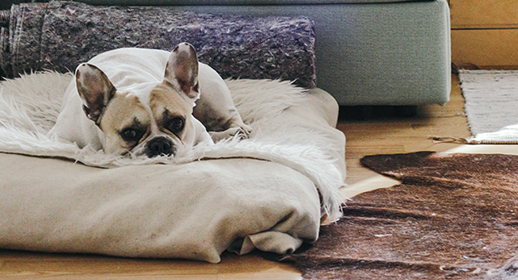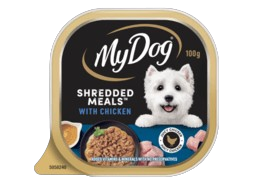

Although many pet parents would love to have their beloved furry friend by their side all day, it simply isn’t possible to take them everywhere you go. This means there are likely going to be times when your dog has to be left by themselves for a little while. Unfortunately, many dogs find it difficult to be away from their humans, especially if they’ve grown used to being in their company. This can lead to them developing separation anxiety, which can occur while they’re on their own and when they sense their owner is going to leave. The good news is, by easing your dog into alone time gradually and keeping an eye out for any signs of stress along the way, it’s possible to prevent separation anxiety from becoming an issue.
What is separation anxiety?
Separation anxiety is a type of anxiety that some dogs experience when they’re not with their owner. This is usually when they’re left by themselves, but some dogs might also feel overwhelmed when they’re being looked after by someone other than their usual family members. While the special bond we create with our furry companions is the absolute best, if they grow too used to being with us all the time, it can leave them feeling a little lost when we’re gone, and even result in undesirable behaviours.
What can cause it to develop?
We don’t really know why some dogs are affected by separation anxiety and others not. Genetics are believed to play a role, as well as prior learning. For example, the dog may not be used to being left alone, they may be a puppy, or even an older dog that is adjusting to their human no longer working from home or a change in schedule. Other possible reasons for separation anxiety include moving into a new home, or a change in the household, such as someone moving in or out. Dogs may also struggle with being left by themselves if something scary once happened to them when they were alone. If this is the case, your love and support will go a long way in putting them at ease.
Spotting separation anxiety in your dog
Our furry friends are all unique, so their separation anxiety will manifest in various ways. Some may become very vocal, while others are quiet but destructive when left to their own devices.
Common symptoms of separation anxiety
- Barking, howling and whining
- Panting and lip licking
- Excessive drooling
- Pacing
- Peeing and pooing inside
- Chewing household items and furniture
- Scratching at the door or trying to escape
- Excessive excitement when you come home
How to prevent separation anxiety
If you’ve got a new puppy, have just adopted an older dog, or a change of circumstances means you need to start leaving your dog alone for the first time, there are a few things you can do to reduce the risk of separation anxiety.
Gradually increase the time you leave them
To get your furry friend used to being left alone, start gradually, and avoid suddenly leaving them for a long period of time. You can start by simply shutting them in a separate room (along with all their creature comforts), so they can adjust to a little bit of separation. Then, begin leaving the house for short periods, gradually increasing the duration over time. It’s also a good idea to vary the amount of time you are away, so that your dog does not associate you leaving with long absences. If you become aware of any howling, barking or signs of upset when you leave, you may need to take extra measures to manage their anxiety.
Stay calm
It's really tempting to make a huge fuss over our furry friends when we leave and arrive home. We do miss them when we’re not with them, after all, but this makes your dog think there’s something to be worried about. For many dogs, it is best to ignore them when you first arrive home and only greet them when they’re calm. Try your best (we know it’s hard!) to stay calm when coming and going, and they’ll hopefully just see it as a normal part of the day.
How to manage separation anxiety
Unless your dog has accidents or you return to chewed up belongings, you may not necessarily realise they’re experiencing separation anxiety. This is where dog cams can come in handy. Not only are they great for checking up on your fur baby so you can coo over how adorable they are, but you can also use them to spot signs of anxiety, such as barking, howling, or pacing. Some even let you dispense treats, so you can give them their treat at a certain time. It’s important that you never scold or punish your dog if you come home to an accident or chewed items, as this could add to their anxiety and make matters worse. Instead, be patient with them and try a few of the following techniques.
Use toys and treats
Teach them that you leaving the house isn’t a bad thing by giving them their favourite toy or a treat whenever you go out. This way, it doesn’t feel so negative. Puzzle toys that dispense treats or kibble are a great distraction and form of entertainment for your pooch. If you have a dog cam that dispenses treats, you can even set it for them to get their treat while you’re out, which might sweeten the experience.
Walk them before you leave
If you take your dog for a nice long walk before leaving them by themselves, they’ll hopefully feel tired enough to relax while you’re out. This will also create a positive link between you leaving and them getting their fun walkies.
Minimise disturbances
Things like cars or passing dog walkers can get your dog excited or riled up. So, to keep their environment as calm as possible, close your curtains to block their view onto the street and consider leaving some music on to drown out other sounds that might disturb them. If the postman or deliveries are likely to upset your dog, you may want to arrange for things to be left with a neighbour when you’re out.
When you might need to speak to your vet
If your poor doggo struggles with separation anxiety and you’ve tried numerous things to help them with no real success, speak to your vet for advice. Your vet may put you in touch with an animal behaviourist who can work with you and your dog to find a solution, or prescribe an anti-anxiety medication. Remember to remain patient with your pooch and give them the love and support they need. Hopefully, by trying some of the techniques above, they’ll adjust nicely to being left at home alone. For more tips on how to keep your dog happy and healthy, check out our blog.
© 2023 Mars or Affiliates.
Buy online
Click to buy from any of the retailers below





